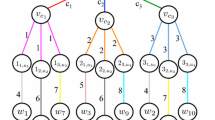Abstract
Given an edge-colored graph G, a tree with all its edges with different colors is called a rainbow tree. The rainbow spanning forest (RSF) problem consists of finding a spanning forest of G, with the minimum number of rainbow trees. In this paper, we present an integer linear programming model for the RSF problem that improves a previous formulation for this problem. A GRASP metaheuristic is also implemented for providing fast primal bounds for the exact method. Computational experiments carried out over a set of random instances show the effectiveness of the strategies adopted in this work, solving problems in graphs with up to 100 vertices.









Similar content being viewed by others
Notes
https://www.geekbench.com/geekbench3, [accessed 16-May-2018].
References
Brualdi RA, Hollingsworth S (2001) Multicolored forests in complete bipartite graphs. Discret Math 240(1–3):239–245
Carraher JM, Hartke SG, Horn P (2016) Edge-disjoint rainbow spanning trees in complete graphs. Eur J Comb 57:71–84
Carrabs F, Cerrone C, Cerulli R, Silvestri S (2018a) On the complexity of rainbow spanning forest problem. Optim Lett 12:443–454
Carrabs F, Cerrone C, Cerulli R, Silvestri S (2018b) The rainbow spanning forest problem. Soft Comput 22(8):2765–2776
Hansen P, Mladenovic N (2001) Variable neighbourhood search: principles and applications. Eur J Oper Res 120:449–467
Hassin R, Monnot J, Segev D (2007) Approximation algorithms and hardness results for labeled connectivity problems. J Comb Optim 14(4):437–453
Kano M, Li X (2008) Monochromatic and heterochromatic subgraphs in edge-colored graphs-a survey. Graphs Comb 24(4):237–263
Krumke SO, Wirth HC (1998) On the minimum label spanning tree problem. Inf Process Lett 66(2):81–85
Lai X, Zhou Y, He J, Zhang J (2014) Performance analysis of evolutionary algorithms for the minimum label spanning tree problem. IEEE Trans Evol Comput 18(6):860–872
Li X, Zhang X (2007) On the minimum monochromatic or multicolored subgraph partition problems. Theor Comput Sci 385(1–3):1–10
Moreno J, Martins S, Frota Y (2019) A note on the rainbow cycle cover problem. Networks 73(1):38–47
Resende MG, Ribeiro CC (2016) Optimization by GRASP. Springer, Berlin
Silvestri S, Laporte G, Cerulli R (2016) The rainbow cycle cover problem. Networks 68(4):260–270
Suzuki K (2006) A necessary and sufficient condition for the existence of a heterochromatic spanning tree in a graph. Graphs and Combinatorics 22(2):261–269
Acknowledgements
This study was funded by Conselho Nacional de Desenvolvimento Científico e Tecnológico. Award numbers for authors in the order they appear: 870038/2002-8, 305889/2015-0 and 301254/2015-0.
Author information
Authors and Affiliations
Corresponding author
Ethics declarations
Conflict of interest
All authors declare that they have no conflict of interest.
Ethical approval
This article does not contain any studies with human participants or animals performed by any of the authors.
Additional information
Communicated by V. Loia.
Publisher's Note
Springer Nature remains neutral with regard to jurisdictional claims in published maps and institutional affiliations.
Rights and permissions
About this article
Cite this article
Moreno, J., Martins, S. & Frota, Y. A new approach for the rainbow spanning forest problem. Soft Comput 24, 3771–3780 (2020). https://doi.org/10.1007/s00500-019-04145-6
Published:
Issue Date:
DOI: https://doi.org/10.1007/s00500-019-04145-6




